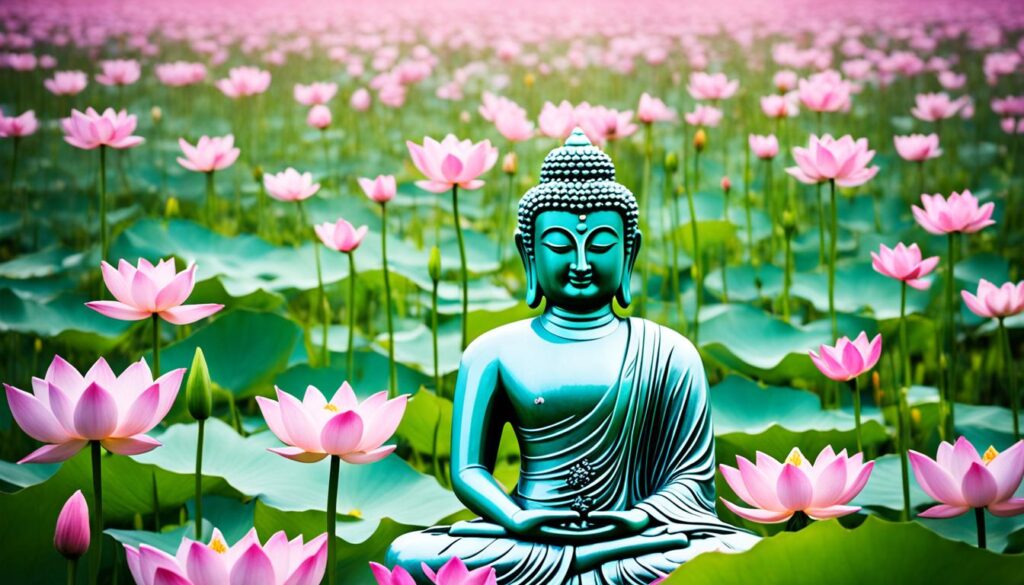“Peace comes from within. Do not seek it without.” – Buddha
Welcome to the serene world of Buddhism culture, where inner peace and harmony hold the key to a fulfilling life. Rooted in the teachings of Gautama Buddha, Buddhism offers profound wisdom and transformative practices that can guide you on a journey of self-discovery, compassion, and enlightenment.
In a fast-paced and chaotic world, the pursuit of peace becomes an essential quest. Buddhism culture provides invaluable insights into understanding the human mind, unraveling the causes of suffering, and cultivating a sense of tranquility within oneself. By embracing the principles of Buddhism, you open the door to a path of purpose, mindfulness, and compassion.
Join us as we explore the rich tapestry of Buddhism culture, delving into its history, traditions, art, philosophy, practices, and beliefs. Discover how these timeless teachings can resonate with you, offering solace, clarity, and guidance in navigating life’s challenges.
Key Takeaways:
- Explore the teachings of Buddhism for inner peace and personal growth
- Understand the impact of mindfulness and compassion in Buddhism culture
- Uncover the history and traditions that shaped Buddhism
- Appreciate the art and philosophy intertwined with Buddhism culture
- Learn about Buddhist practices and rituals that foster spiritual well-being
The Impact of Buddhism Culture on Mindfulness and Compassion.
Buddhism culture has a profound influence on the development of mindfulness and compassion. These two essential qualities are central to the teachings and practices of Buddhism, promoting inner peace and genuine care for others.

Mindfulness, a core principle of Buddhism, involves being fully present in the moment and cultivating awareness of one’s thoughts, emotions, and physical sensations. By practicing mindfulness, individuals can develop a deep understanding of themselves and the world around them, promoting clarity and insight.
Compassion, another fundamental aspect of Buddhism, encourages individuals to extend kindness and empathy towards all sentient beings. The practice of compassion involves cultivating a genuine concern for the well-being and happiness of others, fostering a sense of interconnectedness and unity.
Benefits of Mindfulness and Compassion in Buddhism Culture
The cultivation of mindfulness and compassion in Buddhism culture provides several benefits:
- Reduced stress and anxiety: Mindfulness helps individuals become aware of their patterns of thinking and emotional reactions, allowing them to respond to challenging situations with greater equanimity.
- Enhanced self-awareness: Mindfulness enables individuals to develop a deeper understanding of themselves, their thoughts, and their emotions, leading to self-growth and personal transformation.
- Improved relationships: Compassion fosters empathy, understanding, and forgiveness, creating healthier and more fulfilling connections with others.
- Promotion of social harmony: The practice of compassion in Buddhism culture extends beyond personal relationships to encompass society as a whole, promoting unity, reconciliation, and peace.
Practical Applications of Mindfulness and Compassion
Incorporating mindfulness and compassion into daily life can bring about significant positive changes. Here are some practical applications:
- Mindful Meditation: Engaging in regular meditation practices, such as mindfulness or loving-kindness meditation, helps cultivate mindfulness and compassion.
- Acting with Kindness: Making a conscious effort to treat yourself and others with kindness, empathy, and respect can enhance mindfulness and compassion.
- Volunteering and Service: Engaging in acts of service and volunteering within your community fosters compassion and helps develop a deeper understanding of others’ struggles.
- Being present: Practicing mindfulness in daily activities, such as eating, walking, or even doing chores, promotes a sense of presence and appreciation for the present moment.
Buddhism culture’s emphasis on mindfulness and compassion provides valuable tools for personal growth, inner peace, and the cultivation of a compassionate society. By integrating these practices into our lives, we can create a positive impact on ourselves and those around us.
Exploring the History and Traditions of Buddhism.
Buddhism, a profound and ancient spiritual tradition, traces its roots back to the enlightened teachings of Gautama Buddha. Over time, Buddhism has evolved and spread, giving rise to a rich history and diverse array of traditions.
One key aspect of Buddhism is its categorization into distinct schools, each with its own unique teachings and practices. Let’s take a closer look at three prominent Buddhist traditions: Theravada, Mahayana, and Vajrayana.
Theravada Buddhism
Theravada, also known as the “Doctrine of the Elders,” is the oldest surviving school of Buddhism. Originating in ancient India, it emphasizes the path to enlightenment through personal discipline and meditation.
The Table below provides a brief comparison of Theravada Buddhism:
| Theravada Buddhism | Key Characteristics |
|---|---|
| Origin | India |
| Main Scriptures | Pali Canon (Tipitaka) |
| Focus | Individual liberation and mindfulness |
| Geographical Influence | Southeast Asia (e.g., Thailand, Myanmar, Sri Lanka) |
Mahayana Buddhism
Mahayana, the “Great Vehicle,” emphasizes compassion and the pursuit of enlightenment for the benefit of all sentient beings. This tradition developed in India and later spread to China, Japan, and other parts of East Asia.
The Table below provides a brief comparison of Mahayana Buddhism:
| Mahayana Buddhism | Key Characteristics |
|---|---|
| Origin | India |
| Main Scriptures | Various sutras (e.g., the Lotus Sutra) |
| Focus | Compassion, bodhisattva ideal, and universal liberation |
| Geographical Influence | East Asia (e.g., China, Japan, Korea) |
Vajrayana Buddhism
Vajrayana, known as the “Diamond Vehicle” or “Thunderbolt Vehicle,” is a tantric tradition that emerged in India and found its primary influence in Tibet and the Himalayan region. It emphasizes the use of ritual practices and esoteric techniques to accelerate the path to enlightenment.
The Table below provides a brief comparison of Vajrayana Buddhism:
| Vajrayana Buddhism | Key Characteristics |
|---|---|
| Origin | India |
| Main Scriptures | Tantras and tantras-commentaries |
| Focus | Tantric practices, symbolism, and devotion |
| Geographical Influence | Tibet, Nepal, Bhutan, Mongolia |

These different Buddhist traditions, though distinct in their approaches, all share the common aspiration to alleviate suffering and cultivate wisdom and compassion. The diversity within Buddhism reflects the adaptability of the teachings, making it accessible to individuals from various cultural backgrounds.
As we delve deeper into the art, philosophy, practices, and beliefs of Buddhism, we gain a comprehensive understanding of this timeless tradition and its profound impact on individuals and societies throughout history.
The Art and Philosophy of Buddhism.
Buddhist art and philosophy play a significant role in the expression and understanding of Buddhism. Through artistic representations and philosophical teachings, Buddhism offers a deep insight into the nature of reality, impermanence, and the pursuit of liberation from suffering.
Buddhist art is characterized by its symbolic depictions of enlightened beings and spiritual concepts. These artworks serve as visual narratives, conveying profound teachings and inspiring a sense of awe and contemplation. From intricate mandalas to serene statues of Buddhas and bodhisattvas, Buddhist art provides a glimpse into the divine realms and serves as a powerful tool for meditation and reflection.
Buddhist philosophy delves into profound questions about the nature of existence and the human experience. Central to Buddhist philosophy is the recognition of impermanence (known as anicca) as a fundamental aspect of reality. This understanding allows individuals to cultivate a sense of detachment and non-attachment, leading to the alleviation of suffering.
The philosophy of Buddhism also explores the concept of interconnectedness. It recognizes that all beings are interconnected and that our actions have far-reaching consequences. This understanding forms the basis of ethical behavior and the practice of compassion, kindness, and empathy towards all living beings.
Additionally, Buddhist philosophy examines the nature of the self and the illusion of a fixed, inherent identity. It teaches that the self is a fluid and ever-changing concept, arising from a complex interplay of thoughts, emotions, and external conditions. This realization invites individuals to question their attachments and ego-driven desires, ultimately leading to a deeper understanding of the nature of reality.
The Role of Art and Philosophy in Buddhism
Buddhist art and philosophy are integral parts of the Buddhist tradition, serving as valuable tools for spiritual growth and self-reflection. By engaging with Buddhist art, individuals can immerse themselves in the visual representations of enlightened beings and sacred concepts, enhancing their understanding and connection to the spiritual path.
Similarly, studying Buddhist philosophy provides practitioners with a framework for investigating the nature of reality and the human condition. It offers philosophical insights and practical guidance on how to navigate the challenges of everyday life, promoting self-awareness, mindfulness, and the cultivation of wholesome qualities.
Through the integration of art and philosophy, Buddhism offers a holistic approach to spiritual development, nurturing not only the mind but also the heart. It invites individuals to explore the depths of their own consciousness, cultivate compassion and wisdom, and ultimately find liberation from suffering.
A Glimpse into Buddhist Art and Philosophy
Below is a table highlighting some of the key elements of Buddhist art and philosophy:
| Buddhist Art | Buddhist Philosophy |
|---|---|
| – Symbolic representations of enlightened beings | – Recognition of impermanence |
| – Depictions of spiritual concepts | – Understanding interconnectedness |
| – Invokes a sense of awe and contemplation | – Exploration of the nature of self |
| – Facilitates meditation and reflection | – Cultivation of compassion and wisdom |
Exploring Buddhist Practices and Rituals.
Buddhist practices and rituals play a significant role in the spiritual journey of individuals and communities. These practices help cultivate a sense of inner peace, mindfulness, and compassion. By engaging in these rituals, practitioners deepen their connection with the teachings of Buddhism and the path to enlightenment.
One of the key practices in Buddhism is meditation. This ancient technique involves focusing one’s attention and achieving a deep sense of presence and awareness. Through regular meditation, individuals can develop clarity of mind, reduce stress, and cultivate inner tranquility.
Chanting is another essential practice in Buddhism. By reciting sacred chants and mantras, practitioners create a rhythmic resonance that harmonizes their mind, body, and spirit. Chanting acts as a powerful tool to cultivate mindfulness and connect with the divine.
The observance of moral precepts is also significant in Buddhism. These principles guide individuals to live a virtuous and ethical life. By adhering to these precepts, practitioners cultivate compassion, integrity, and respect for all living beings.
Rituals are an integral part of Buddhist culture and are performed in various ceremonies and daily practices. These rituals symbolize reverence and devotion to the teachings of Buddhism.
In Buddhist ceremonies, offerings of food are made to express gratitude, generosity, and interconnectedness. These offerings remind practitioners of the importance of nourishing both the body and the soul.

Another common ritual is the lighting of incense, symbolizing the purity of intentions and the transcendence of suffering. The gentle fragrances of incense create a serene atmosphere, inviting practitioners to find solace and peace within themselves.
Bowing is yet another ritual practiced in Buddhism. By bowing, individuals express humility, gratitude, and surrender. It is an act of honoring the divine, as well as showing respect to teachers and fellow practitioners.
These practices and rituals offer profound opportunities for self-reflection and spiritual growth. They provide individuals with practical tools to cultivate mindfulness, compassion, and a deep connection with themselves and the world around them.
Understanding Buddhist Beliefs.
Buddhism is a profound and ancient spiritual tradition that encompasses a rich tapestry of beliefs and teachings. Central to Buddhist philosophy are the Four Noble Truths, which provide insights into the nature of suffering, its causes, and the path to liberation.
The first Noble Truth acknowledges the existence of suffering, reminding us that it is an inherent part of the human experience. The second Truth delves into the causes of suffering, identifying attachment and craving as the primary drivers of our discontentment.
Through recognizing the root causes of suffering, Buddhism offers a transformative path towards liberation. This path is guided by the third Noble Truth, which illuminates the cessation of suffering. By cultivating mindfulness, compassion, and wisdom, individuals can transcend their deeply ingrained patterns of attachment and find true inner freedom.
The fourth Noble Truth introduces the Eightfold Path as a practical guide for overcoming suffering and attaining enlightenment. This path encompasses principles such as right understanding, right intention, right speech, right action, right livelihood, right effort, right mindfulness, and right concentration.
The Concept of Karma
Another fundamental belief in Buddhism is the concept of karma. This concept suggests that our intentions, thoughts, words, and actions create an imprint on our consciousness and influence our future experiences. Karma reminds us of the interconnectedness of our choices and the consequences they can bring.
Rebirth and the Pursuit of Enlightenment
Buddhism also contemplates the idea of rebirth, highlighting the cyclical nature of existence. According to Buddhist belief, individuals experience a continuous cycle of birth, death, and rebirth, shaped by their karmic imprints from previous lives.
The ultimate goal in Buddhism is to break free from this cycle through the attainment of enlightenment, known as Nirvana. Enlightenment represents a state of awakened awareness, profound wisdom, and liberation from suffering. It is a state of complete transcendence, where the ego dissolves, and one experiences the interconnectedness and interdependence of all beings.

| Key Beliefs in Buddhism |
|---|
| The Four Noble Truths |
| The concept of karma |
| Rebirth and cyclic existence |
| The pursuit of enlightenment (Nirvana) |
Buddhism’s Relevance in Addressing Modern Challenges.
In today’s fast-paced and chaotic world, individuals face numerous modern challenges, from stress and anxiety to societal conflicts. Buddhism culture offers valuable insights and practices that can help navigate these obstacles and cultivate a sense of inner peace and harmony.
The teachings of Buddhism promote peace, compassion, and ethical conduct as essential principles for living a fulfilling life. By incorporating these teachings into your daily routine, you can develop resilience and emotional well-being, enabling you to better cope with the challenges of modern living.
One of the core practices in Buddhism is mindfulness, which involves being fully present in the moment and cultivating awareness of your thoughts, emotions, and sensations. Mindfulness can help you manage stress, reduce anxiety, and enhance your overall well-being.
Additionally, Buddhism emphasizes the importance of compassion towards oneself and others. By developing empathy and kindness, you can foster stronger relationships, build bridges of understanding, and contribute to a harmonious society.
Furthermore, the ethical guidelines outlined in Buddhism culture, such as the Five Precepts, provide a moral compass for navigating the complexities of modern life. These principles encourage you to refrain from harming others, engage in honest communication, and live with integrity.
By embracing the wisdom and practices of Buddhism culture, you can find solace and guidance in the face of modern challenges. Through self-reflection, mindfulness, compassion, and ethical living, you can cultivate a sense of inner peace and contribute to a more harmonious world.
Buddhism’s Contributions to Addressing Modern Challenges
| Modern Challenges | Buddhism’s Contributions |
|---|---|
| Stress | Mindfulness practices for stress reduction and emotional regulation |
| Anxiety | Cultivation of mindfulness and compassion to alleviate anxiety |
| Societal Conflicts | Ethical guidelines promoting peace, compassion, and understanding |
By understanding and applying the principles and practices of Buddhism culture, you can navigate the challenges of modern life with resilience, compassion, and a deeper sense of inner peace.
Conclusion
Embracing the peace of Buddhism culture can lead to a profound inner transformation and a deeper understanding of oneself and others. The principles and practices of Buddhism provide a transformative framework for personal growth, fostering societal harmony, and nurturing the pursuit of a more peaceful world.
By delving into the teachings of Buddhism, you embark on a path that encourages self-reflection, mindfulness, and compassion. Buddhism offers profound insights into the nature of suffering, its causes, and the paths to liberation. These teachings empower individuals to cultivate inner peace and extend empathy and kindness towards all beings.
Through the practice of meditation, you can develop a heightened awareness of the present moment, enabling you to better navigate modern challenges such as stress and anxiety. The wisdom of Buddhism equips individuals with ethical guidelines and principles that guide their actions, contributing to a more harmonious society.
As you embrace the peace of Buddhism culture, you embark on a journey of self-discovery and connection with the world around you. The profound teachings and practices of Buddhism have the potential to inspire a profound shift in your perspective and enhance your overall well-being, enriching not only your own life but also the lives of those you encounter along your path.
FAQ
What is Buddhism centered on?
Buddhism is centered on examining the human mind and addressing the root causes of suffering.
What insights does Buddhism offer?
The teachings of Buddhism offer insights into achieving inner peace and promoting harmony in both personal and societal levels.
What does mindfulness involve in Buddhism?
Buddhism emphasizes the cultivation of mindfulness, which involves being fully present in the moment and developing awareness of one’s thoughts and emotions.
What is a key component in Buddhism?
Compassion is also a key component of Buddhism, as it encourages individuals to extend kindness and empathy towards others.
Who is the founder of Buddhism?
Buddhism originated with Gautama Buddha and has evolved over time through the teachings of various masters.
What are the different schools of Buddhism?
The tradition is categorized into different schools, such as Theravada, Mahayana, and Vajrayana, each with its own distinct teachings and practices.
How is Buddhist art characterized?
Buddhist art is characterized by its symbolic representations of enlightened beings and spiritual concepts.
What does Buddhist philosophy delve into?
Buddhist philosophy delves into the nature of reality, the concept of impermanence, and the pursuit of liberation from suffering.
What are some Buddhist practices?
Buddhist practices include meditation, chanting, and the observance of moral precepts.
What are common rituals in Buddhism?
Rituals such as offering food, lighting incense, and bowing are common in Buddhist ceremonies and signify reverence and devotion.
What are the Four Noble Truths in Buddhism?
The Four Noble Truths address the nature of suffering, its causes, and the path to liberation.
What are some central beliefs in Buddhism?
Central beliefs in Buddhism include the concept of karma, rebirth, and the pursuit of enlightenment or Nirvana.
How can Buddhism help with modern challenges?
Buddhism offers insights and practices that can help individuals navigate modern challenges such as stress, anxiety, and societal conflicts.
How can embracing Buddhism culture impact personal growth?
Embracing the peace of Buddhism culture can lead to a path of inner transformation and a greater understanding of oneself and others.
What principles do the teachings of Buddhism promote?
The principles and practices of Buddhism provide a framework for personal growth, societal harmony, and the pursuit of a more peaceful world.

